Integrated Geophysical Signatures of the Jiaodong Region in China and Their Implications for Deep Architecture and Gold Metallogenic Systems
Abstract
1. Introduction
2. Regional and Tectonic Geological Setting
3. Gravity Field Characteristics and Tectonic Response
3.1. Gravity Anomaly Characteristics
3.2. EW-Trending Basement Structures and Gravity Field Response
3.3. NE-Trending Fault Structures and Gravity Field Responses
4. Characteristics of Aeromagnetic Anomalies and Tectonic Response
4.1. Characteristics of Aeromagnetic Anomalies
4.2. Aeromagnetic Response of Faults and Intrusions
4.3. Characteristics of Deep-Seated Aeromagnetic Anomalies and Ore Deposit Distribution
5. Magnetotelluric Characteristics and Tectonic Implications
5.1. Data Acquisition and Processing
5.2. Deep Electrical Structure
6. Discussion
6.1. North China Craton–Sulu Ultrahigh-Pressure Metamorphic Belt Boundary
6.2. Jiaodong Gold Metallogenic System and Exploration Directions
- (1)
- Source of ore-forming materials: During the Triassic, the Yangtze Block subducted beneath the North China Craton to depths of tens to hundreds of kilometers, accompanied by orogenesis that formed the Jiaobei Uplift. In the Jurassic, the retreat of the Pacific Plate induced mantle upwelling, leading to the detachment and melting of the subducted lithospheric lower crust. The melted lower crust mixed with the upper mantle, providing metallogenic materials for the Jiaodong gold cluster. Therefore, the TJF serves as a critical tectonic boundary, the Jiaobei Uplift represents the leading edge of the Yangtze Block subduction-collision, while the Sulu Ultrahigh-Pressure Metamorphic Belt marks the collisional suture zone. The region west of the TJF—specifically the Jiaobei Uplift—hosts favorable conditions for mineralization, whereas the area east of the fault (Sulu Ultrahigh-Pressure Belt) exhibits relatively limited ore-forming potential. Furthermore, it is inferred that the collision front is bounded by the TLF, the rear boundary by the TJF, and the southern margin by the EW-trending basement structural belt along the northern edge of the JLB (Figure 3). The northern side of the Jiaobei Uplift remains unclosed, with aeromagnetic anomalies indicating that the ZPF and TJF extend northward into the Bohai Sea, suggesting potential mineralization in offshore areas.
- (2)
- Ore-forming migration pathways: The NE-trending faults in the Jiaodong region can be broadly categorized into three types: Category 1: Deep Major Strike-Slip Faults (e.g., TLF, TJF), which act as boundary faults between tectonic plates or geological units, exerting fundamental control over the regional distribution of gold deposits in the Jiaodong region. Category 2: Extensional Low-Angle Detachment Faults, which are predominantly distributed in the Jiaobei Uplift and exhibit a characteristic geometry with steep upper segments and gentle lower segments. As typical extensional structures, they extend to depths exceeding 4 km and include major ore-controlling faults such as SSDF, JJF, ZPF, QXF, and MRF. Notably, the SSDF, JJF, and ZPF zones collectively host over 4000 tons of proven gold resources [1]. Existing studies indicate that the majority of Jiaodong gold deposits formed at depths of 5–10 km, followed by regional uplift and approximately 5 km of erosion during post-mineralization stages [1]. Consequently, the ore-hosting fractures associated with gold enrichment originated at depths exceeding 10 km, representing basement-scale structures. Crust–mantle hybrid hydrothermal fluids enriched in ore-forming elements ascended through magmatic conduits or boundary faults (e.g., the TLF) during mantle upwelling. These fluids migrated into shallow crustal structures such as extensional faults, where they cooled and precipitated gold through pressure reduction and sulfide-driven metal scavenging [13]. Category 3: Steeply Dipping Linear Faults, which are primarily distributed near the eastern side of the TJF and exhibit nearly equidistant parallel alignment with the TJF. Examples include the GCF, Muping fault, and HYF. They formed during the retreat of the Pacific Plate, with a burial depth of less than 5 km and steep angles (>60°). Due to their limited depth and unfavorable structural geometry, mineralization-enriched materials struggle to accumulate, rendering these faults generally barren of ore deposits.
7. Conclusions
- (1)
- The Bouguer gravity anomalies in the Jiaodong region exhibit an overall pattern of lower values in the north and higher values in the south, with block-like structures segmented in east–west directions and interspersed with belt-shaped anomalies. This reflects the tectonic framework of “two uplifts sandwiching a basin” (Jiaobei Uplift and Weihai Uplift flanking the JLB) and the EW-trending basement folds or rock formations, which collectively control the primary distribution pattern of gold deposits in Jiaodong.
- (2)
- The aeromagnetic anomalies in the Jiaodong region exhibit an eastward trend characterized by increasing anomaly values (from moderate to high) and transitioning from chaotic to coherent distribution patterns, reflecting intense Mesozoic magmatism and traces of plate collision. These anomalies further indicate that the ZPF and TJF extend northward into the offshore areas.
- (3)
- Magnetotelluric Sounding has revealed deep-seated fault systems and crustal characteristics associated with mineralization in the Jiaodong region. Notably, electrical signatures of lithospheric thinning, mantle upwelling, and Moho uplift have been identified in the Jiaobei Uplift, bounded by the TJF. In addition, three Y-shaped fault systems or magmatic channels of varying scales, penetrating the lower crust and lithosphere, have been identified, providing migration pathways and storage spaces for the enrichment of gold mineralization.
- (4)
- The TJF penetrates the entire lithospheric crust and exhibits prominent strike-slip characteristics. The geological units east of the fault have been displaced ~27 km northeastward, influenced by the retreat of the Pacific Plate and subsequent tectonic modifications. It is inferred that the northern segment of the TJF underwent clockwise extensional rotation during later stages. This fault serves as the tectonic boundary between the North China Craton and the Sulu Ultrahigh-Pressure Metamorphic Belt.
- (5)
- The next phase of gold exploration in the Jiaodong region should focus on the northwestern study area, specifically north of the SZQMF and west of the TJF. The Sanshandao-Longkou zone and its northern offshore areas exhibit immense prospecting potential.
Author Contributions
Funding
Data Availability Statement
Acknowledgments
Conflicts of Interest
References
- Song, M.C.; Wang, H.J.; Liu, H.B.; He, C.Y.; Wei, Y.T.; Li, J.; Cao, J.J.; Niu, S.Y.; Tian, J.X.; Li, X.Z.; et al. Deep characteristics of ore−controlling faults in Jiaoxibei gold deposits and its implications for prospecting: Evidence from geophysical surveys. Geol. China 2024, 51, 1–16. (In Chinese) [Google Scholar] [CrossRef]
- Goldfarb, R.J.; Pitcairn, I. Orogenic gold: Is a genetic association with magmatism realistie? Miner. Depos. 2023, 58, 5–35. [Google Scholar] [CrossRef]
- Song, M.C.; Cui, S.X.; Zhou, M.L.; Jiang, H.L.; Yuan, W.H.; Wei, X.F.; Lü, G.X. The Deep Oversize Gold Deposit in the Jiaojia Field, Shandong Province and Its Enlightenment for the Jiaojia gold type. Acta Geol. Sin. 2010, 84, 1349–1358. (In Chinese) [Google Scholar]
- Zhai, M.G.; Fan, H.R.; Yang, J.H.; Miao, L.C. Large-Scale Cluster of Gold Deposits in East Shandong: Anorogenic Metallogenesis. Earth Sci. Front. 2004, 11, 85–98. (In Chinese) [Google Scholar]
- Deng, J.; Wang, Q.F.; Zhang, L.; Xue, S.C.; Liu, X.F.; Yang, L.; Yang, L.Q.; Qiu, K.F.; Liang, Y.Y. Metallogenetic model of Jiaodong-type gold deposits, eastern China. Sci. China Earth Sci. 2023, 66, 2287–2310. [Google Scholar] [CrossRef]
- Li, L.; Santosh, M.; Li, S.R. The ‘Jiaodong type’ gold deposits: Characteristics, origin and prospecting. Ore Geol. Rev. 2015, 65, 589–611. [Google Scholar] [CrossRef]
- Groves, D.I.; Santonsh, M. The giant Jiaodong gold province: The key to a unified model for ogenic gold deposits? Geosci. Front. 2016, 7, 409–417. [Google Scholar] [CrossRef]
- Wang, H.J.; Tian, H.J.; He, C.Y.; Liu, G.D. An analysis of the effect of multiple geophysical prospecting methods in the deep exploration of the Jiaoxibei (northwest Shandong) gold ore concentration area. Geophys. Geochem. Explor. 2020, 44, 1053–1058. (In Chinese) [Google Scholar] [CrossRef]
- Chen, D.L.; Wang, R.S.; He, C.Y.; Wang, X.; Yin, Z.K.; Yu, J.B. Application of integrated geophysical exploration in deep spatial structures: A case study of Jiaodong gold ore concentration area. Geophys. Geochem. Explor. 2022, 46, 70–77. (In Chinese) [Google Scholar] [CrossRef]
- He, C.Y.; Yao, Z.; Guo, G.Q.; Liu, H.B.; Song, M.C.; Li, S.Y.; Chen, D.L.; Liu, W. Deep structural features of the Jiaobei terrane of Jiaodong and the North Sulu orogenic belt: The inspiration from deep exploration of the geophysics. Prog. Geophys. 2022, 37, 1392–1404. (In Chinese) [Google Scholar] [CrossRef]
- Zhang, K.; Lü, Q.T.; Yan, J.Y.; Hu, H.; Fu, G.M.; Shao, L.S. Crustal structure beneath the Jiaodong Penisula, North China, revealed with a 3D inversion model of magnetotelluric data. J. Geophys. Eng. 2018, 15, 2442–2454. [Google Scholar] [CrossRef]
- Teng, X.J.; Fu, C.; Li, J.J.; Li, Z.D.; Tang, W.L. Characteristics and Geological Implications of the Ophiolite Belts in the Sino-Mongolian Border Region. North China Geol. 2024, 47, 1–13. (In Chinese) [Google Scholar] [CrossRef]
- Yang, L.Q.; Deng, J.; Zhang, L.; Yang, W.; Xie, D.; Wang, L.; Qiu, K.F.; Li, D.P. Jiaodong-type gold deposit. Acta Petrol. Sin. 2024, 40, 1691–1711. [Google Scholar] [CrossRef]
- Li, S.Z.; Hao, D.F.; Han, Z.Z.; Zhao, G.C.; Sun, M. Paleoproterozoic Deep Processes and Tectono-thermal Evolution in Jiao-Liao Massif. Acta Geol. Sin. 2003, 77, 328–340. (In Chinese) [Google Scholar]
- Zheng, Y.F.; Xiao, W.J.; Zhao, G.C. Introduction to tectonics of China. Gondwana Res. 2013, 23, 1189–1206. [Google Scholar] [CrossRef]
- Zhao, R.; Wang, Q.F.; Deng, J.; Santosh, M.; Liu, X.F.; Liang, Y.Y.; Cheng, H.Y. Characterizing episodic orogenesis and agmatism in eastern China based on detrital zircon from the Jiaolai Basin. Am. J. Sci. 2019, 319, 500–525. [Google Scholar] [CrossRef]
- Zhai, M.G.; Zhao, L.; Zhu, X.Y.; Jiao, S.J.; Zhou, Y.Y.; Zhou, L.G. Review and overview for the frontier hotspot: Early continents and start of plate tectonics. Acta Petrol. Sin. 2020, 36, 2249–2275. (In Chinese) [Google Scholar] [CrossRef]
- Yang, L.Q.; Deng, J.; Wang, Z.L.; Zhang, L.; Guo, L.N.; Song, M.C.; Zheng, X.L. Mesozoic gold metallogenic system of the Jiaodong gold province, eastern China. Acta Petrol. 2014, 30, 2447–2467. [Google Scholar]
- Yu, R.; Si, Q.; Peng, S. Comprehensive exploration techniques and Practices for Sandstone type uranium deposit: A case study of BYH uranium deposit in Erlian Basin. North China Geol. 2024, 47, 23–35. [Google Scholar]
- Zhang, Y.Q. Cretaceous to Paleocene tectono-sedimentary evolution of the Jiaolai basin and in the contiguous areas of Shandong peninsular (North China) and geodynamic implications. Acta Geol. Sin. 2008, 82, 1229–1257. (In Chinese) [Google Scholar]
- Song, M.C.; Xu, J.X.; Wang, P.C.; Cui, S.X.; Huang, T.L.; Liu, M.W.; Liang, B.Q.; Wan, Z.J.; Hu, S.T.; Wang, L.F.; et al. The Geotectonic Framework and Geological Structural Evolution of Shandong Province; Geological Publishing House: Beijing, China, 2009; pp. 1–274. (In Chinese) [Google Scholar]
- Zhang, K.; Lü, Q.T.; Yan, J.Y.; Shao, L.S.; Guo, D.; Zhang, Y.W. The subduction and continental collision of the North China and Yangtze blocks: Magnetotelluric evidence from the Susong-Anqing section of western Anhui, China. Geophys. J. Int. 2019, 216, 2114–2128. [Google Scholar] [CrossRef]
- Newman, G.A.; Alumbaugh, D.L. Three-dimensional magnetotelluric inversion using non-linear conjugate gradients. Geophys. J. Int. 2000, 140, 410–424. [Google Scholar] [CrossRef]
- Zhang, K.; Dong, H.; Yan, J.Y.; Lü, Q.T.; Wei, W.B.; He, Y.X. A parallel nonlinear conjugate gradient 3D inversion approach for magnetotelluric fields. Chin. J. Geophys. 2013, 56, 3922–3931. [Google Scholar]
- Zhang, K.; Wei, W.B.; Lü, Q.T.; Dong, H.; Li, Y.Q. Theoretical assessment of 3-D magnetotelluric method for oil and gas exploration: Synthetic examples. J. Appl. Geophys. 2014, 106, 23–36. [Google Scholar] [CrossRef]
- Zhang, K.; Yan, J.Y.; Lü, Q.T.; Zhao, J.H.; Hu, H. Three-dimensional nonlinear conjugate gradient parallel inversion with full information of marine magnetotellurics. J. Appl. Geophys. 2017, 139, 144–157. [Google Scholar] [CrossRef]
- Cao, G.Q. A Preliminary Discussion on the “Jiaonan Terrane”. Shandong Geol. 1990, 6, 1–10. (In Chinese) [Google Scholar]
- Lin, J.T. Problems on the Tectonic Unit Division and Their Boundaries in Eastern Shandong. Geol. Bull. China 1993, 2, 158–166+193+130. (In Chinese) [Google Scholar]
- Wang, L.M. A preliminary study on the Ludong collision zone. Shandong Geol. 1994, 10, 100–108. (In Chinese) [Google Scholar]
- Gu, D.L.; Zhang, C.H.; Chen, J.Q. Geological Structural Characteristics and Evolution of the Northern Jiaonan Uplift; China University of Geosciences Press: Wuhan, China, 1996; pp. 1–30. (In Chinese) [Google Scholar]
- Zhai, M.G.; Cong, B.L.; Guo, J.H.; Liu, W.J.; Li, Y.G.; Wang, Q.C. Sm-Nd Geochronology and Petrography of Garnet Pyroxene Granulites in the Northern Sulu Region and Their Geotectonic Implication. Chin. J. Geol. 1999, 34, 301–310. (In Chinese) [Google Scholar] [CrossRef]
- Wang, L.M.; Song, M.C.; Wang, P.C. Study Development on Jiaonan-Weihai Tectonic Belt and Discussion of Some Important Geological Problems. Shandong Geol. 2002, 18, 78–93. (In Chinese) [Google Scholar]
- Yu, G.P.; Xu, T.; Liu, J.T.; Ai, Y.S. Late Mesozoic extensional structures and gold mineralization in Jiaodong Peninsula, eastern North China Craton: An inspiration from ambient noise tomography on data from a dense seismic array. Chin. J. Geophys. 2020, 63, 1878–1893. (In Chinese) [Google Scholar] [CrossRef]
- Pan, S.Z.; Wang, F.Y.; Zheng, Y.P.; Duan, Y.L.; Liu, L.; Deng, X.G.; Song, X.H.; Sun, Y.N.; Ma, C.J.; Li, Y.Q. Crustal velocity structure beneath Jiaodong Peninsula and its tectonic implications. Chin. J. Geophys. 2015, 58, 3251–3263. (In Chinese) [Google Scholar] [CrossRef]
- Zhu, R.X.; Fan, H.R.; Li, J.W.; Meng, Q.R.; Li, S.R.; Zeng, Q.D. Decratonic gold deposits. Sci. China Earth Sci. 2015, 58, 1523–15337. [Google Scholar] [CrossRef]
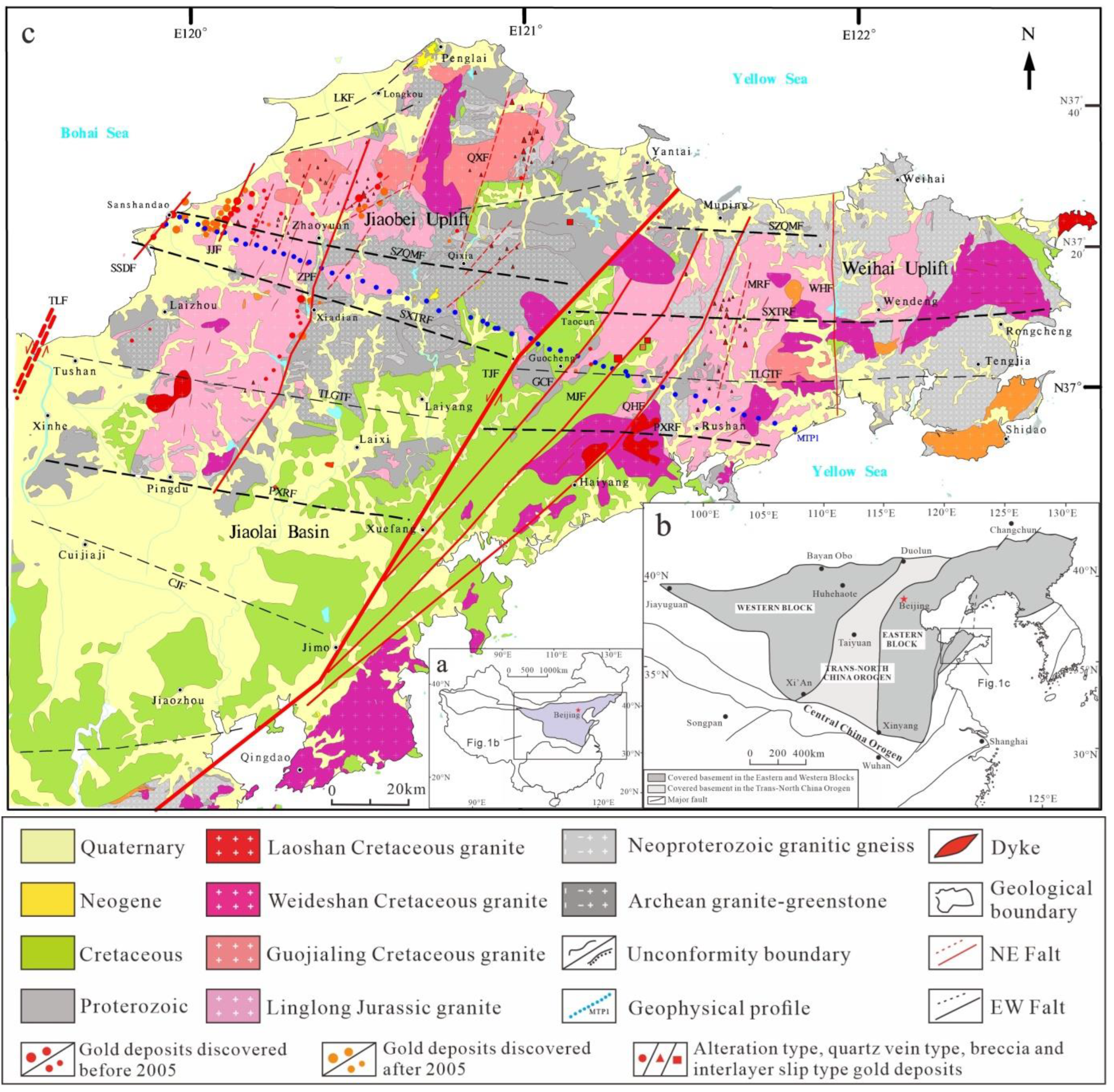
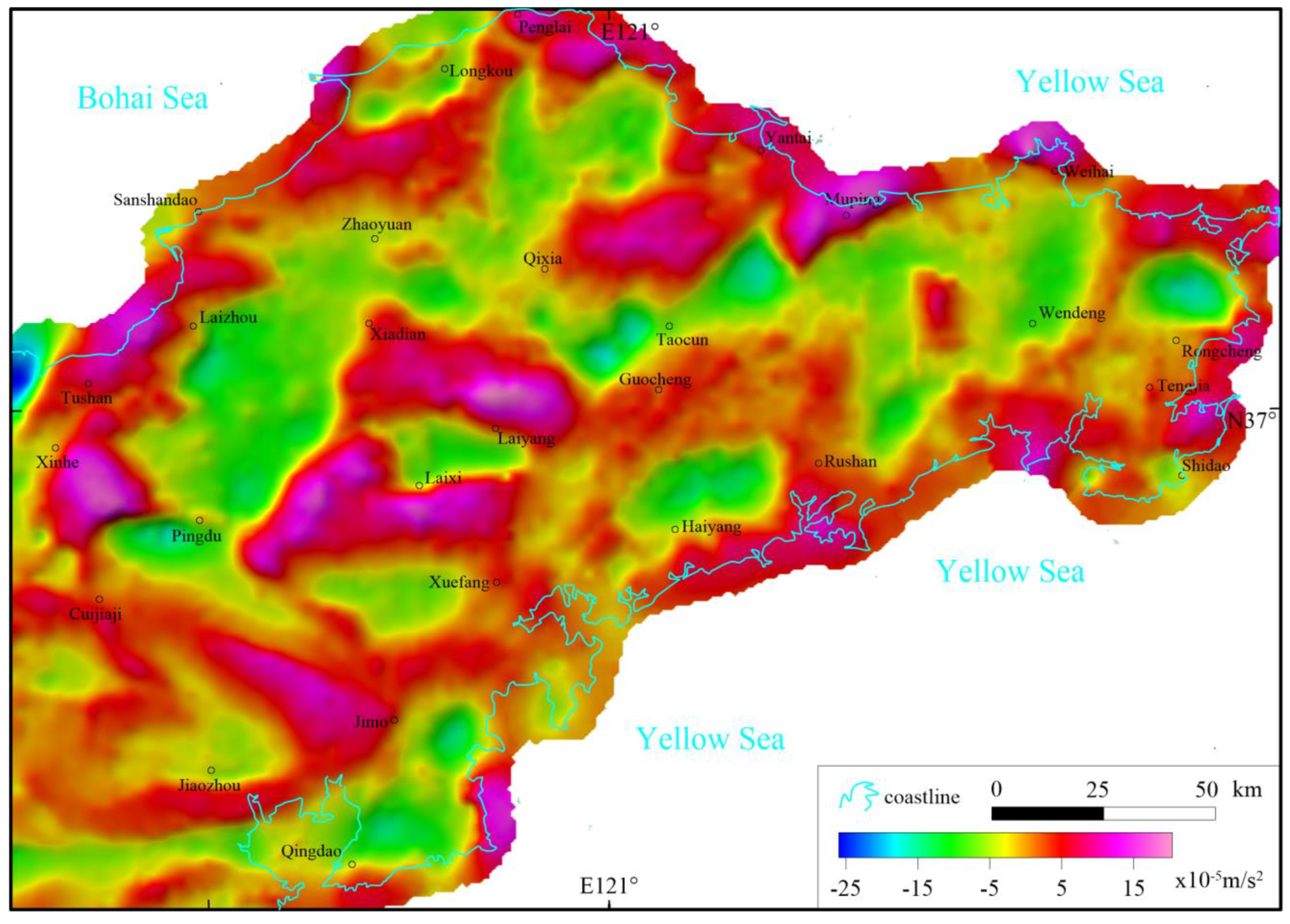
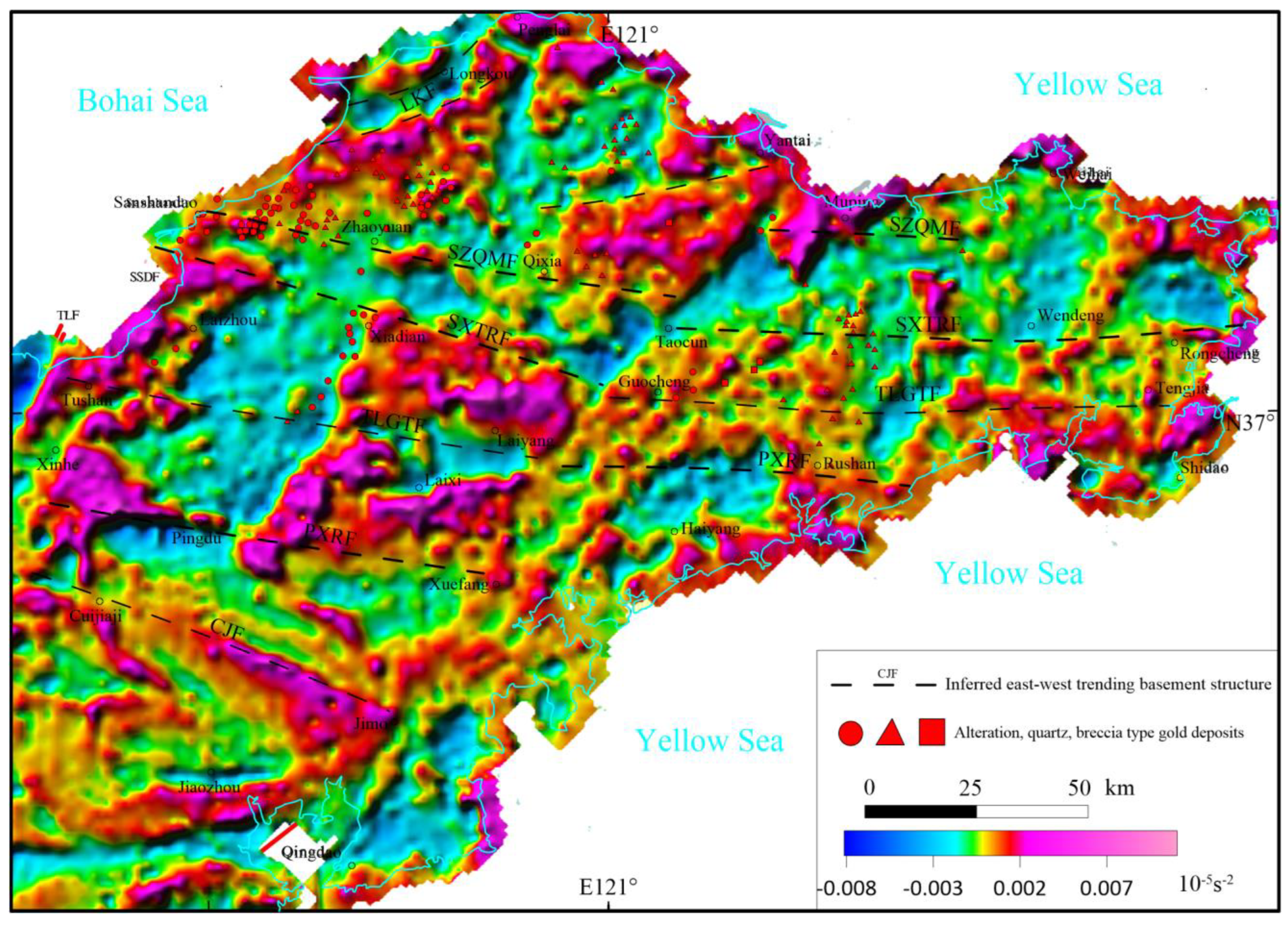



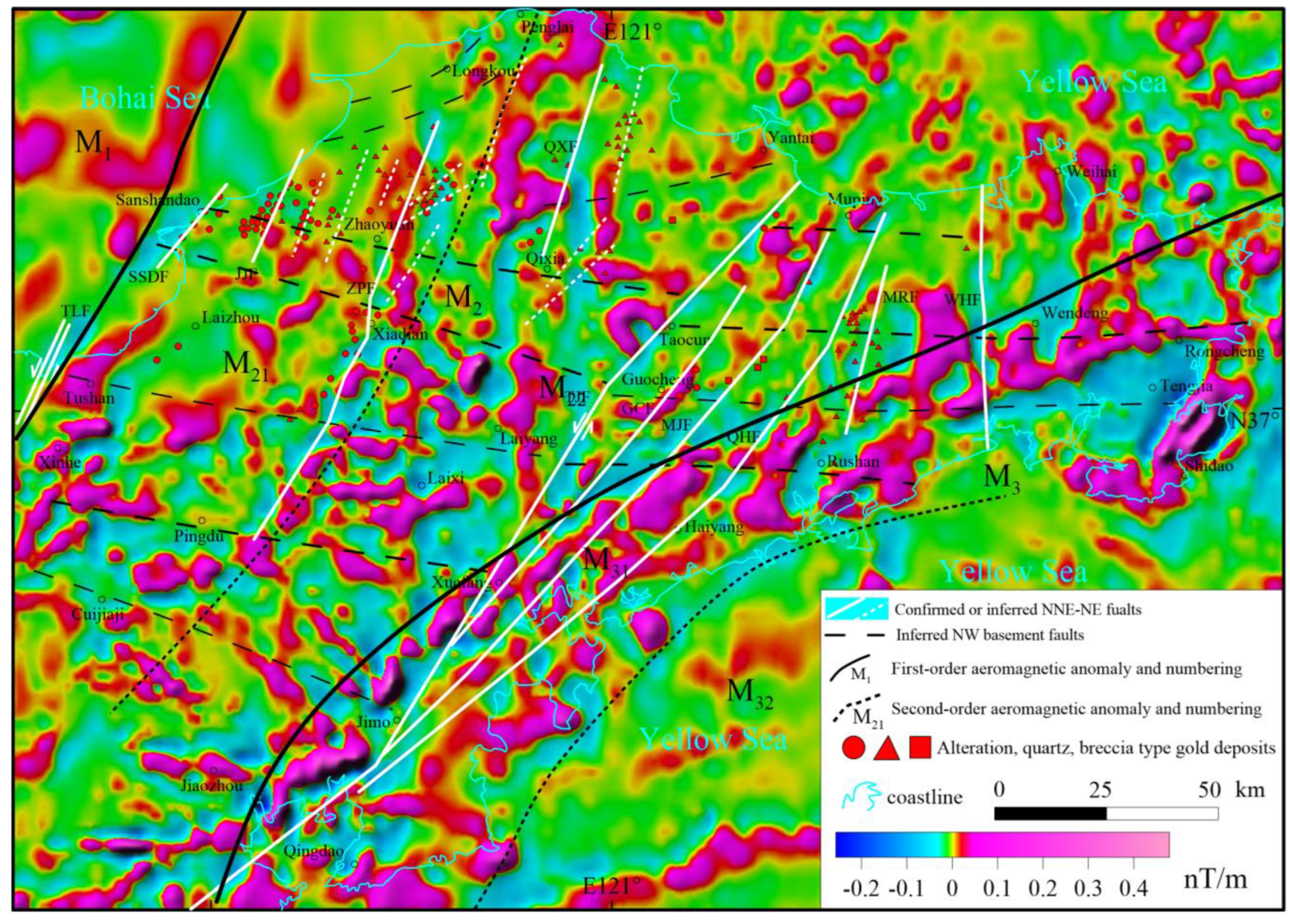
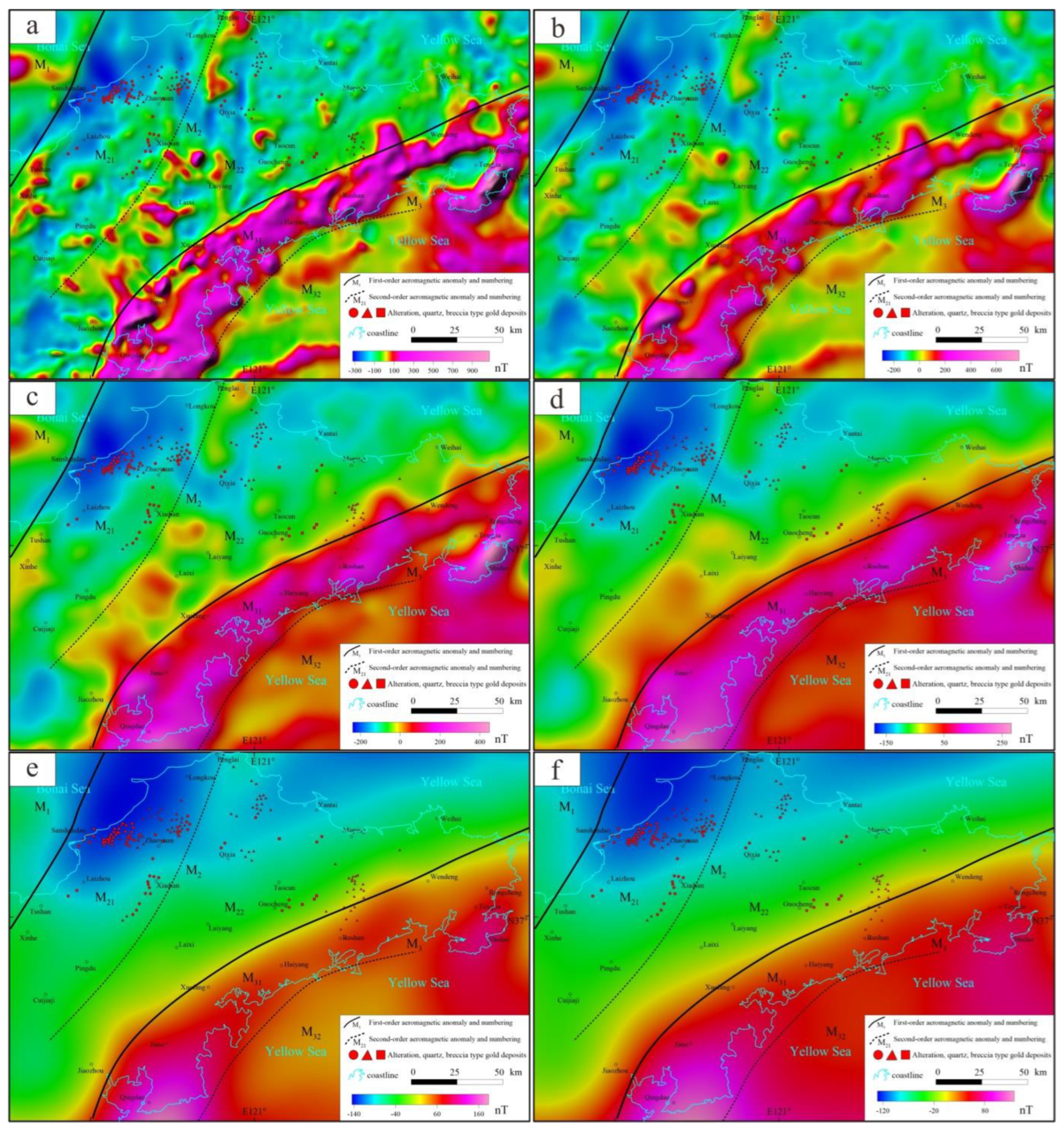


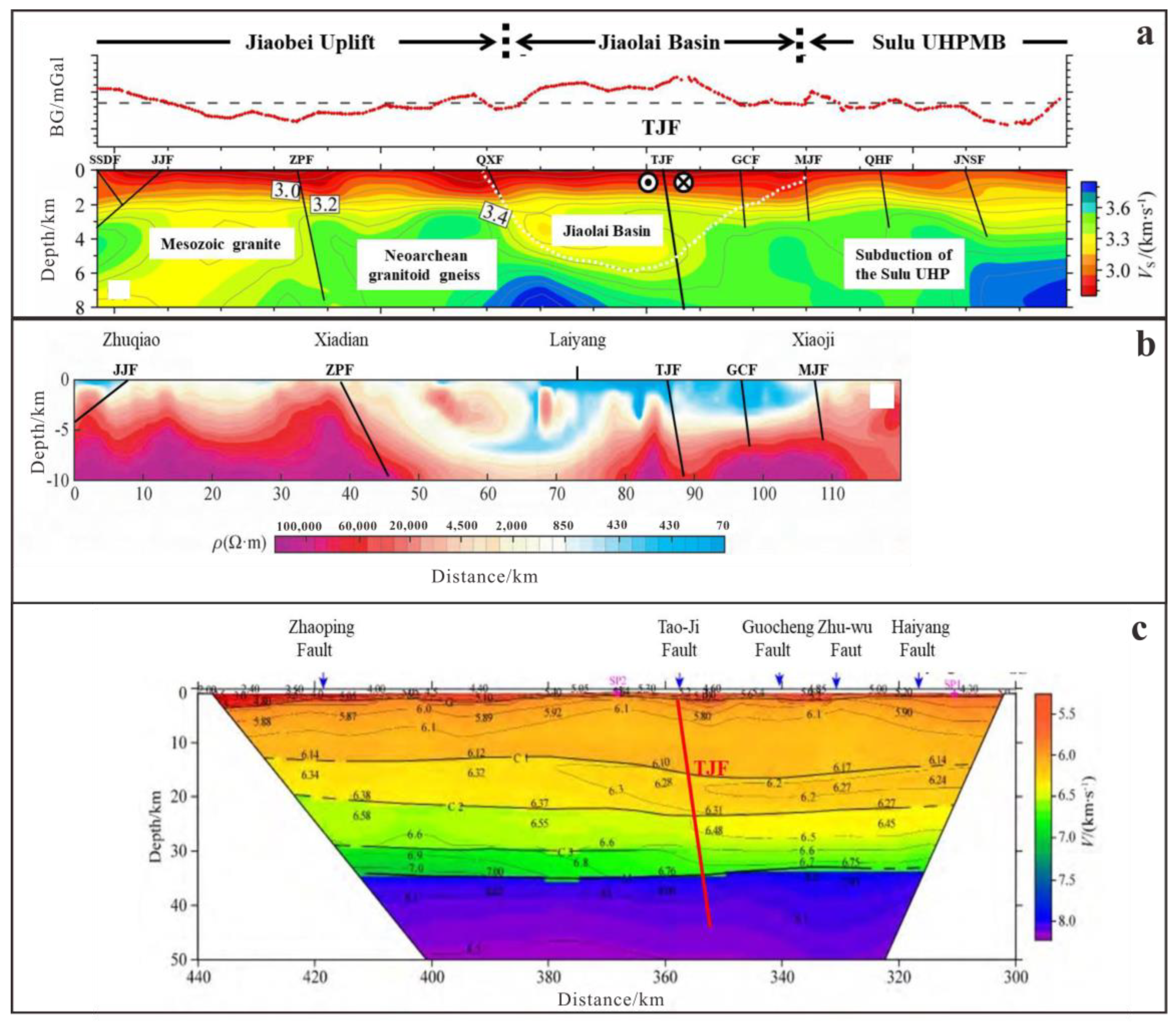


Disclaimer/Publisher’s Note: The statements, opinions and data contained in all publications are solely those of the individual author(s) and contributor(s) and not of MDPI and/or the editor(s). MDPI and/or the editor(s) disclaim responsibility for any injury to people or property resulting from any ideas, methods, instructions or products referred to in the content. |
© 2025 by the authors. Licensee MDPI, Basel, Switzerland. This article is an open access article distributed under the terms and conditions of the Creative Commons Attribution (CC BY) license (https://creativecommons.org/licenses/by/4.0/).
Share and Cite
Kuang, H.; Yan, J.; Zhang, K.; Tang, W.; Fu, C.; Liang, J.; Zhang, G.; You, Y. Integrated Geophysical Signatures of the Jiaodong Region in China and Their Implications for Deep Architecture and Gold Metallogenic Systems. Minerals 2025, 15, 417. https://doi.org/10.3390/min15040417
Kuang H, Yan J, Zhang K, Tang W, Fu C, Liang J, Zhang G, You Y. Integrated Geophysical Signatures of the Jiaodong Region in China and Their Implications for Deep Architecture and Gold Metallogenic Systems. Minerals. 2025; 15(4):417. https://doi.org/10.3390/min15040417
Chicago/Turabian StyleKuang, Haiyang, Jiayong Yan, Kun Zhang, Wenlong Tang, Chao Fu, Jiangang Liang, Guoli Zhang, and Yuexin You. 2025. "Integrated Geophysical Signatures of the Jiaodong Region in China and Their Implications for Deep Architecture and Gold Metallogenic Systems" Minerals 15, no. 4: 417. https://doi.org/10.3390/min15040417
APA StyleKuang, H., Yan, J., Zhang, K., Tang, W., Fu, C., Liang, J., Zhang, G., & You, Y. (2025). Integrated Geophysical Signatures of the Jiaodong Region in China and Their Implications for Deep Architecture and Gold Metallogenic Systems. Minerals, 15(4), 417. https://doi.org/10.3390/min15040417







